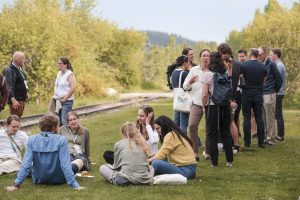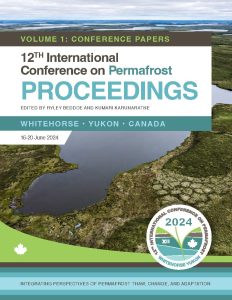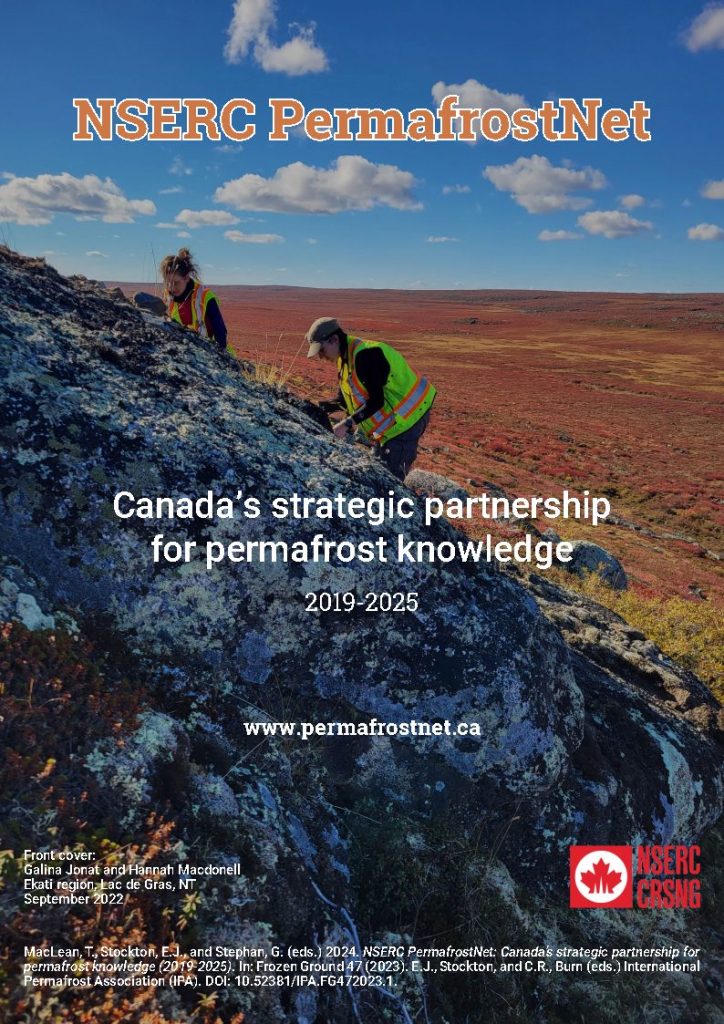The 12th International Conference on Permafrost was in Whitehorse, YT between the 16th and 20th of June, 2024.
Canada welcomed the international permafrost community to Whitehorse, Yukon for the 12th International Conference on Permafrost (ICOP2024) from June 16-20.
The conference was held at the the Kwanlin Dün Cultural Centre (KDCC) on the banks of the Chu Nínkwän (Yukon River), on the Traditional Territory of the Kwanlin Dün First Nation and Ta’an Kwächän Council.
The theme of the conference was “Integrating Perspectives of Permafrost Thaw, Change, and Adaptation.” with a program that had over 30 distinct technical sessions across a wide range of permafrost-related subjects. The program included 227 oral presentations, 199 in-person posters, and 67 virtual posters.
Network members were involved in planning the conference, giving keynote presentations, and chairing sessions, with many network researchers, partners and collaborators delivering oral (further details below) and poster presentations (see them here). The conference was both in-person and online with former network post-doctoral fellow Mahya Roustaei chairing the virtual sessions.

Pre-conference workshops
On the Sunday prior to the conference there were a number of workshops and meetings.
Le sous-thème Permafrost Young Researchers Network (PYRN) organized a workshop attended by a host of students, graduates, and presenters. Speakers shared their job paths, choices, and funny anecdotes, showing that there is no set path to success or finding a fulfilling career. Victor Leshyk then gave a lecture on visualizing science, which was both informative and eye-opening. Students had the opportunity to try and draw their science in a way that would be easily understood by the general public and received feedback for improvement.
National Research Council of Canada (NRC) convened a workshop on Challenges and Best Practices in Assessment, Monitoring, and Retrofit of Permafrost Housing Foundations. Galina Jonat gave a presentation at the workshop introducing why and how permafrost modelling can be useful for people working on permafrost housing foundations.
Permafrost Pathways and the Arctic Athabaskan Council co-hosted a workshop titled – Call to Action on Permafrost: Applying Knowledge and Research to Complex Problems Facing Communities. The workshop was attended by the NSERC PermafrostNet Board Chair Dr. Janet King and Director of Operations Dr. Tristan MacLean.
Keynotes
- Pascale Roy-Léveillée (Monday) – Permafrost dynamics and landscape evolution in the thermokarst plain of Old Crow Flats.
- Jocelyn Hayley (Wednesday) – Permafrost Thaw in a Changing Climate: A Geotechnical Perspective.
- Chris Burn (Thursday) – A Field Experiment with Permafrost in Takhini River Valley, Southern Yukon.
Permafrost data and permafrost climate services

Members of the network also co-convened a technical session covering permafrost data and permafrost climate services. The session featured oral presentations and posters by the network’s partners and participants. These presentations covered a variety of topics including developing a conceptual framework for classifying permafrost terrain (Niek Speetjens – NSERC PermafrostNet), the Northwest Territories Permafrost Database (Niels Weiss – Northwest Territories Geological Survey) and best-practices for permafrost data (Nick Brown – NSERC PermafrostNet). In addition, the session included contributions from researchers in Germany, the Netherlands, Nepal, Alaska, and Norway; demonstrating that permafrost data really is a global challenge.
Networking reception
NSERC PermafrostNet held a networking reception on Tuesday evening at the Old Firehall to showcase of the network’s research through a compendium of projects featured in the latest issue of Frozen Ground.

Oral presentations
1A – Communities, People and Permafrost
Permafrost thaw slump impacts on culturally and ecologically important fish habitat in the Peel River Watershed, Canada – Jackie Ziegler
Exploring Traditional Knowledge of Permafrost in the Gwich’in Settlement Area and Inuvialuit Settlement Region – Emma Street
1B – Permafrost Data Management and Climate Services
Best-practices for permafrost data: actionable recommendations for field scientists and database managers – Nick Brown
4B – Periglacial Geomorphology
Permafrost Degradation in Dendritically-Drained Peat Plateaus Over the Past 70 Years in the Central Mackenzie Valley, Northwest Territories – Alexandre Chiasson
4D – Permafrost temperature, active layer thickness, and rock glacier velocity
The impact of observation depth and depth of zero annual amplitude on the interpretation of permafrost warming – Nick Brown
4E – Permafrost Mass Wasting Processes
Permafrost detachment slides: A novel high magnitude mass wasting process in discontinuous permafrost – Joseph Young
Retrogressive thaw slump activity in the western Canadian Arctic (1984- 2016) – Antoni Lewkowicz
5B – Monitoring, modelling, and remote sensing of the permafrost carbon feedback
Multi-objective soil organic carbon parameter optimization for more accurate quantification of the permafrost carbon feedback – Joe Melton
6A – Implications of Thawing permafrost on Water Resources in Cold Regions
Multi-year and Seasonal Trends in the Water Quality of the Niaqunguk River, Nunavut (2013-2018) – Erika Hille
6B – Drained Lake Basins in lowland permafrost region
Catastrophic lake drainages and landscape evolution in Old Crow Flats, Yukon, Canada – Pascale Roy-Léveillée
Post-Drainage Evolution of an Old Drained Lake Basin in Old Crow Flats, Yukon, Canada – Danielle Chiasson
6C – Arctic wetlands in a changing climate
Mercury storage and cycling in thawing permafrost peatlands of the Hudson Bay Lowlands – Adam Kirkwood
7D – Permafrost engineering, geomorphology, hydrology for northern linear infrastructure
Characterizing permafrost conditions in the central Mackenzie Valley corridor using airborne electromagnetic methods (AEM) and ground- based investigations – Duane Froese
8A – Vulnerability of Cold Regions Infrastructure
Thaw Settlement Potential Map of Canada – Zakieh Mohammadi
Cost Increases for Highway Maintenance in a Permafrost Environment Undergoing Climate Change, Yukon, Canada – Astrid Schetselaar
8B – Advances in numerical modelling of permafrost
Improving plot-scale prediction of future permafrost change by reducing the bias in climate model-derived driving data – Galina Jonat
8C – Geomechanics and engineering geophysics for permafrost
A numerical investigation of ice-filled discontinuities relating to rock mass destabilization due to ice-rock detachment – Stephan Gruber
8D – Investigating Permafrost using geophysical techniques
Large-scale assessment of permafrost conditions using the Canadian Permafrost Electrical Resistivity Survey (CPERS) database – Teddi Herring
12B – Exploring the roles of ground ice on permafrost dynamicsIce-wedge development in the Barrens of the Hudson Bay Lowlands, northern Manitoba – Tabatha Rahman




Poster presentations
Frostbytes
Le sous-thème Permafrost Young Researchers Network (PYRN) also organized a series of “Frostbytes” to communicate the research being conducted. Frostbytes are bite-sized video presentations of “cool” research.
You can see the full playlist here.
Conference proceedings
The ICOP2024 Conference Proceedings were compiled into two volumes, with Volume 1 comprising 64 Full Papers (6-8 pages), and Volume 2 comprising 429 Extended Abstracts (2 pages). Both volumes are available on the IPA website ici or by clicking on the images below.
Thank you
Big thank you to the organizers, in particular NSERC Permafrost Board member Lukas Arenson who was the ICOP 2024 Conference Chair, Kumari Karunaratne who oversaw all publications of the conference, Ryley Beddoe who developed the program, Nick Brown who sat on the National Organizing committee and the communications committee, Fabrice Calmels for the field excursions, and Brian Horton for the local arrangements.

Further details are available here on the conference website.
Mini-Compendium of research projects
Networking reception

























































































